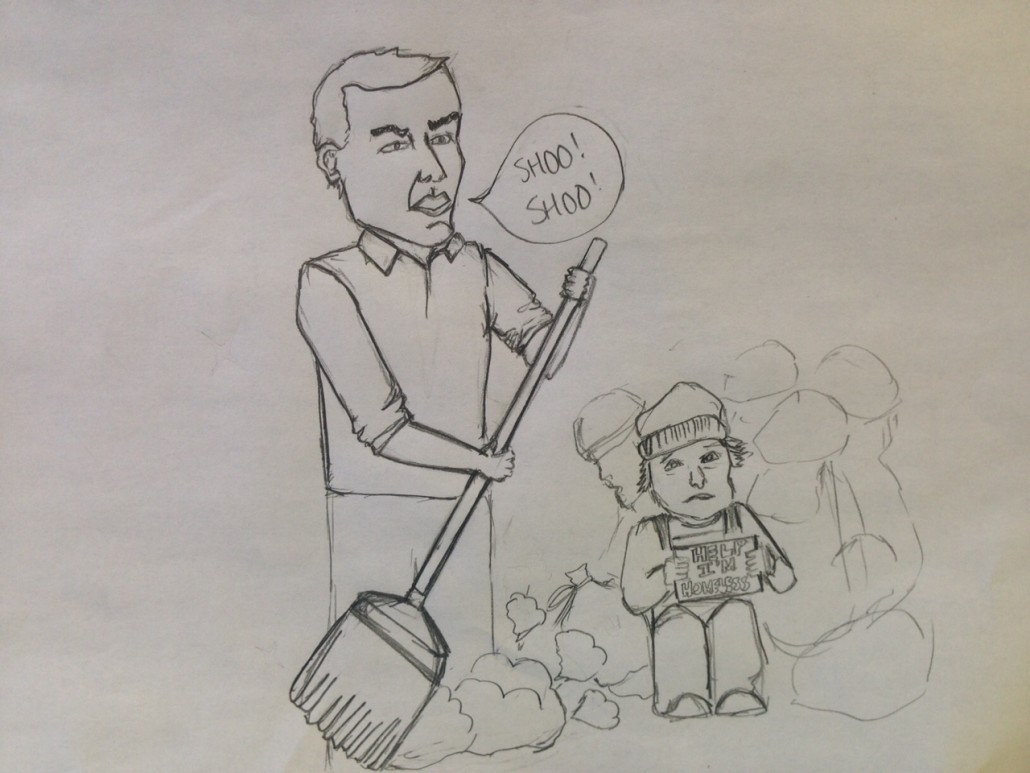Ordinances reveal hostility toward homeless
One of Mayor Eric Garcetti’s most ambitious goals is to get Los Angeles out of the housing crisis.
That’s why standing in front of Circa, a $500 million dollar luxury complex whose grandeur prompts comparisons to Times Square, the mayor celebrated a cultural renaissance in the city last month as well as an economic revitalization of downtown Los Angeles. However, just a few days later, he was silent about nearby Skid Row activists protesting both delays in the construction of affordable housing projects as well as the recent passage of city ordinances 56.11 and 63.44, which criminalize homeless encampments in the area.
Garcetti’s silence on city ordinances 56.11 and 63.44 reinforces accusations of Los Angeles’ history of housing discrimination; the bills grant legal authority for the seizure of homeless encampments and codify a “cleansing” of public areas at the expense of local residents. Violators are given 24 hours to remove all belongings from public sidewalks before their houses can be legally dismantled and their possessions destroyed. Without the means to pay fines and purchase housing, an entire community’s history and way of life have become illegal under city law.
For a mayor who promised to build 100,000 new houses by 2021, this criminalization of homelessness underscores the city’s hostility to impoverished residents. A lack of compassionate policy solutions to the housing crunch sweeps away poor, primarily black and Latino residents’ property in the name of “economic revitalization.”
The mayor is right about the need for housing solutions. Los Angeles is known for problems with housing equality, from its vacancy rate, which is lower than New York City’s, to its stunted housing permits per capita, which is lower than San Francisco’s. The majority of the city’s homeless remain primarily black and Latino, and minority families with discounted housing vouchers face traditional hostility in newer, suburban neighborhoods. The city’s notoriously brutal treatment of Skid Row residents and anemic municipal support for subsidized housing only worsen the rent/wage discrepancy and hike up the city’s historically high poverty rates. The establishment of 650 luxury condominiums, however, is an inappropriate response to housing inequities, and Garcetti’s lack of constructive dialogue only makes the city’s horrendous history of housing abuse all the more apparent.
Harassment of the homeless downtown takes after a history of housing discrimination in the city. A 1968 epidemic of overt refusals of home sales and bank loans to black home buyers prompted the Fair Housing reforms in 1968, and almost two decades later, police crackdowns on Skid Row destroyed entire communities and left them without support or housing solutions.
But even the fatal March shooting of a black homeless Skid Row resident raised questions over the brutal Los Angeles Police Department tactics in the area; while Los Angeles has taken large strides from the overt discrimination from the 1940s, the city’s languid response to homelessness and police brutality mark a tradition of neglect. The municipal government’s obsession with “cleaning the streets” and victimizing the homeless creates violent living conditions for those already struggling to survive.
Today, the homeless spike in Los Angeles presents uncomfortable discussions about race and class amid the city’s remarkable economic and cultural growth. While construction cranes and new businesses dot the skylines of Century City, Santa Monica and downtown L.A., homeless shelters and housing projects support less than a third of the city’s homeless population. The mayor’s race for a new, cleaner town prompts questions over what his cleansing entails; Garcetti’s lack of response to police crackdowns on people’s homes and pandering to luxury business development hints at a vision for the city which excludes the needs of the minority groups who require it most.
Los Angeles’ homeless need homes, not forced relocation policies that pressure them to leave. Affordable housing models have already been proven in large metropolitan areas to provide the poor with shelter and reduce stress on social services, but over 50 percent of Los Angeles’ homeless budget ends up in the hands of the police.
Utah’s Housing First program, which provided thousands of homeless residents with homes, saved tens of thousands of dollars in social services all while treating people with basic respect. Los Angeles may be a completely different beast, but it certainly needs more humane solutions to poverty than current policies. As it increases its rapid pace of Downtown development, the city must not lose sight of a population struggling to find their own home.
At USC, students take classes two metro stops away from one of the largest homeless populations in the United States. On a closed campus at one of America’s finest research institutions, it is easy to forget the privilege of living in a house, much less finding a home.
Especially in a city enjoying a massive surge in urban development, students must look beyond “economic revitalization” rhetoric and search for the families and the faces impacted by Los Angeles’ race towards urbanization. Organizations for housing sustainability in immigrant and low-income neighborhoods are fighting to preserve a way of life in a city already difficult to live in. Finding solutions to an unsustainable housing system may be a requisite first step toward building the city as a home for everyone.
